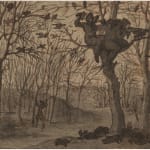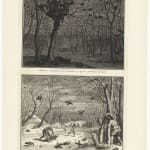
Bernard Picart, Manières de prendre les Corneilles en hyver, pendant la nuit, 1730.
etching, illustration for:
Noel Chomel, Dictionnaire oeconomique, contenant divers moïens d'augmenter son bien,
et de conserver sa santé, Amsterdam, Johannes Covens en Cornelis Mortier, 1732.
Rijksmuseum, RP-P-1921-179.
Bernard Picart (Paris 1673 - 1733 Amsterdam)
Bernard Picart was one of the most accomplished and intellectually engaged engravers of the early 18th century. Trained in Paris under his father, the engraver Étienne Picart, and later at the Académie Royale, he quickly distinguished himself for his refined technique and classical clarity of line. After periods of study in Antwerp and The Hague, Picart settled permanently in Amsterdam in 1711, where he became a leading figure in the city's cosmopolitan publishing scene. Working at the intersection of art, scholarship, and Enlightenment ideals, Picart is best known for his monumental series Cérémonies et coutumes religieuses de tous les peuples du monde (1723–1737). This ambitious, multi-volume work—produced in collaboration with the publisher Jean-Frédéric Bernard—offered a sweeping visual compendium of global religious practices, underpinned by a spirit of philosophical inquiry and religious tolerance. His engravings combined ethnographic curiosity with formal elegance, providing European audiences with an unprecedented view of the world's diverse belief systems.
Beyond this magnum opus, Picart illustrated a wide range of literary, historical, and classical texts, including works by Ovid, La Fontaine, and Boileau. His style is marked by crisp linework, balanced compositions, and an acute sensitivity to narrative and character. His prints were widely disseminated and influential, contributing to the visual culture of the Enlightenment. The present amusing drawing, almost Symbolist in style, depicts a nightly hunting party catching crows. It is a preparatory drawing for a print, more specifically a book illustration for Noël Chomel's Dictionnaire Oeconomique, first published in Amsterdam in 1732. This was the most popular domestic encyclopedia of agriculture and house-keeping of the 18th century, dealing with a wide range of subjects such as garden design, water divination, beekeeping, cooking and home medicine. Most of the 80 folding engraved plates, however - including the print after the present work - illustrate the catching of birds, fish and animals.


